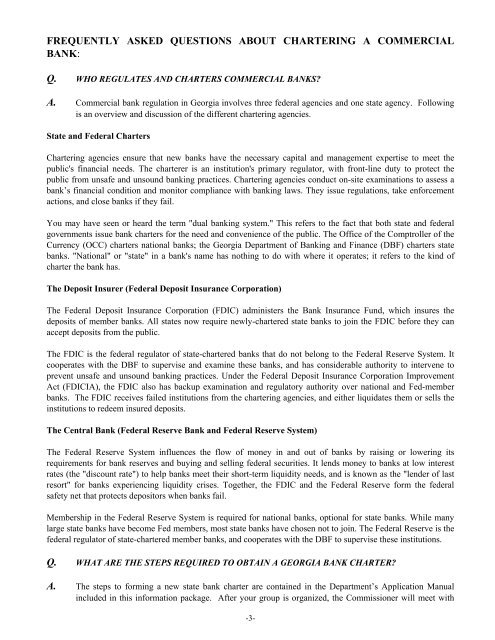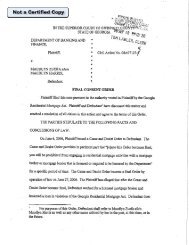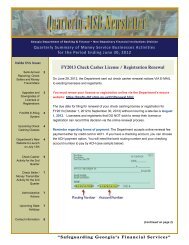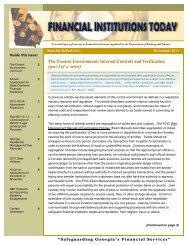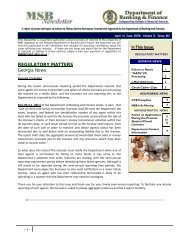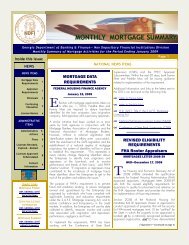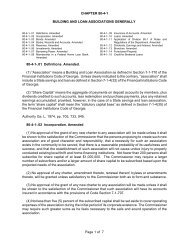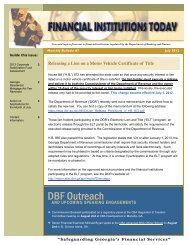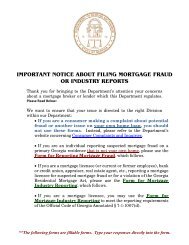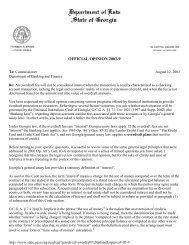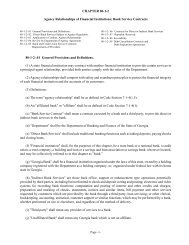facts about chartering a state-chartered bank - Department of ...
facts about chartering a state-chartered bank - Department of ...
facts about chartering a state-chartered bank - Department of ...
You also want an ePaper? Increase the reach of your titles
YUMPU automatically turns print PDFs into web optimized ePapers that Google loves.
FREQUENTLY ASKED QUESTIONS ABOUT CHARTERING A COMMERCIAL<br />
BANK:<br />
Q. WHO REGULATES AND CHARTERS COMMERCIAL BANKS?<br />
A. Commercial <strong>bank</strong> regulation in Georgia involves three federal agencies and one <strong>state</strong> agency. Following<br />
is an overview and discussion <strong>of</strong> the different <strong>chartering</strong> agencies.<br />
State and Federal Charters<br />
Chartering agencies ensure that new <strong>bank</strong>s have the necessary capital and management expertise to meet the<br />
public's financial needs. The charterer is an institution's primary regulator, with front-line duty to protect the<br />
public from unsafe and unsound <strong>bank</strong>ing practices. Chartering agencies conduct on-site examinations to assess a<br />
<strong>bank</strong>’s financial condition and monitor compliance with <strong>bank</strong>ing laws. They issue regulations, take enforcement<br />
actions, and close <strong>bank</strong>s if they fail.<br />
You may have seen or heard the term "dual <strong>bank</strong>ing system." This refers to the fact that both <strong>state</strong> and federal<br />
governments issue <strong>bank</strong> charters for the need and convenience <strong>of</strong> the public. The Office <strong>of</strong> the Comptroller <strong>of</strong> the<br />
Currency (OCC) charters national <strong>bank</strong>s; the Georgia <strong>Department</strong> <strong>of</strong> Banking and Finance (DBF) charters <strong>state</strong><br />
<strong>bank</strong>s. "National" or "<strong>state</strong>" in a <strong>bank</strong>'s name has nothing to do with where it operates; it refers to the kind <strong>of</strong><br />
charter the <strong>bank</strong> has.<br />
The Deposit Insurer (Federal Deposit Insurance Corporation)<br />
The Federal Deposit Insurance Corporation (FDIC) administers the Bank Insurance Fund, which insures the<br />
deposits <strong>of</strong> member <strong>bank</strong>s. All <strong>state</strong>s now require newly-<strong>chartered</strong> <strong>state</strong> <strong>bank</strong>s to join the FDIC before they can<br />
accept deposits from the public.<br />
The FDIC is the federal regulator <strong>of</strong> <strong>state</strong>-<strong>chartered</strong> <strong>bank</strong>s that do not belong to the Federal Reserve System. It<br />
cooperates with the DBF to supervise and examine these <strong>bank</strong>s, and has considerable authority to intervene to<br />
prevent unsafe and unsound <strong>bank</strong>ing practices. Under the Federal Deposit Insurance Corporation Improvement<br />
Act (FDICIA), the FDIC also has backup examination and regulatory authority over national and Fed-member<br />
<strong>bank</strong>s. The FDIC receives failed institutions from the <strong>chartering</strong> agencies, and either liquidates them or sells the<br />
institutions to redeem insured deposits.<br />
The Central Bank (Federal Reserve Bank and Federal Reserve System)<br />
The Federal Reserve System influences the flow <strong>of</strong> money in and out <strong>of</strong> <strong>bank</strong>s by raising or lowering its<br />
requirements for <strong>bank</strong> reserves and buying and selling federal securities. It lends money to <strong>bank</strong>s at low interest<br />
rates (the "discount rate") to help <strong>bank</strong>s meet their short-term liquidity needs, and is known as the "lender <strong>of</strong> last<br />
resort" for <strong>bank</strong>s experiencing liquidity crises. Together, the FDIC and the Federal Reserve form the federal<br />
safety net that protects depositors when <strong>bank</strong>s fail.<br />
Membership in the Federal Reserve System is required for national <strong>bank</strong>s, optional for <strong>state</strong> <strong>bank</strong>s. While many<br />
large <strong>state</strong> <strong>bank</strong>s have become Fed members, most <strong>state</strong> <strong>bank</strong>s have chosen not to join. The Federal Reserve is the<br />
federal regulator <strong>of</strong> <strong>state</strong>-<strong>chartered</strong> member <strong>bank</strong>s, and cooperates with the DBF to supervise these institutions.<br />
Q. WHAT ARE THE STEPS REQUIRED TO OBTAIN A GEORGIA BANK CHARTER?<br />
A. The steps to forming a new <strong>state</strong> <strong>bank</strong> charter are contained in the <strong>Department</strong>’s Application Manual<br />
included in this information package. After your group is organized, the Commissioner will meet with<br />
-3-


